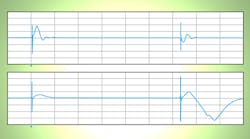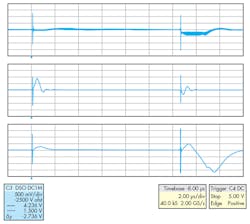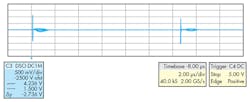Overcome the Challenges of In-line Phase Motor Current Measurement
This file type includes high-resolution graphics and schematics when applicable.
Dan Harmon, Marketing Manager, Current and Power Measurement Product Line, Texas Instruments
Precise motor control has gained greater significance as electrification takes over the automotive industry. Whether for electronic power steering, electronic stability control, automatic braking systems, or for the self-driving vehicle, precise control of these motors is required to ensure safe and efficient operation.
In this article, I will discuss the challenges in measuring in-line motor phase current. I will review how these are addressed by various current-sense amplifiers and introduce a new approach to addressing the challenge. Finally, I will discuss how using precision current measurement can optimize the motor control solution.
Why Measure Current for Motor Control?
There are two primary reasons why current is measured in motor-control circuitry:
• Fault protection
• Input for motor control algorithm
Overcurrent protection circuitry is used to detect out-of-range operational conditions that may indicate a fault in the system. This circuitry is used to identify a stall condition, a bad connection, or even the motor’s health. By detecting when the overcurrent condition occurs, it allows the system to take action to prevent potential damage. This can range from simple overcurrent-detection circuitry to complex current monitoring by the control circuitry.
The motor controller uses current measurement to garner information primarily on motor torque. The current measurement is directly proportional to the motor torque. Current measurement can also be used to determine the speed at which the motor is turning. Such speed information can be calculated by understanding how the control algorithm affects the current level.
Three-Phase Motor-Control Current-Monitoring Options
This article’s focus will be on measuring the current for a three-phase topology. The topology, commonly used on brushless dc (BLDC) motors that are electrically commutated, offers four operating modes: run, coast, brake, and reverse. This is the most complex motor arrangement. There are four ways to monitor the current in this topology: high-side dc-link sensing, low-side dc-link sensing, low-side phase sensing, and in-line phase sensing (Fig. 1).
1. This example circuitry shows the four current-measurement methods used for three-phase motor-control systems.
High-side dc-link sensing is typically used only for fault detection. It has the advantage of having a stable common-mode voltage and enables motor fault detection. However, depending on the motor, the common-mode voltage could be very high, limiting the choice of devices able to be used in this implementation. In addition, the driver current, which is actually what’s being measured, doesn’t necessarily equal motor phase current.
Low-side dc-link sensing is also typically only used for fault detection. It has the advantage of having a common-mode voltage that’s essentially 0 V, broadening the range of available solutions. However, it doesn’t allow for motor fault detection. Furthermore, the driver current, which is actually what’s being measured, doesn’t necessarily equal the motor phase current. Determining the phase current at this location requires very high-speed, high-slew-rate amplifiers and fairly complex algorithms in the controller.
Low-side phase sensing allows for easier determination of the motor phase currents, but it’s not an exact equivalent. Therefore, an error is potentially introduced relative to the true phase current. Low-side phase sensing also introduces a ground variation of the motor relative to system ground. Due to the location of the sense element, fault detection is limited in this implementation.
It does offer the advantage of having more options for implementation, as the common-mode voltage is essentially ground, which enables the use of low-voltage amplifiers. However, due to the nature of the current through the drivers, a high-slew-rate amplifier is again required to respond to the dynamic nature of the current being monitored in each leg. In many cases, only two of the phases are measured, with the third phase calculated in the controller.
2. These current-sense amplifier outputs show the required settling time when exposed to a common-mode PWM signal with a 40-V/10-µs slew rate.
Finally, in-line phase sensing offers true motor phase-current measurement for optimizing the quality of the information being provided to the motor-control algorithm. The major challenge is that the common-mode voltage is a pulse-width-modulated (PWM) signal, which causes a disruption of the output signal unless good PWM rejection circuitry is enabled. This leads to more strenuous requirements for the current-sense amplifier, which must have both very good dc and ac common-mode rejection ratio (CMRR).
In-line Phase Current Measurement
When measuring in-line, there’s no guess work on the phase current. However, as I pointed out earlier, the common-mode voltage seen by the current-sense amplifier is a high-voltage PWM that must be rejected. The frequency of the signal seen by the current-sense amplifier has two contributors:
1. Differential signal (useful information) is relatively narrowband and small amplitude.
2. Common-mode PWM signal (not useful) is wideband and large amplitude.
An ideal in-line current-sense amplifier would only process the differential signal, while rejecting the common-mode signal. This high voltage combined with high ΔV/ΔT poses a steep challenge that limits the availability of suitable current-sense amplifiers. This tends to limit the adoption of this topology to only those applications that require precise phase-current measurement, such as that for electronic power-steering systems.
Minimizing the PWM Effect on the Amplifier Output
The common-mode PWM signal causes an unbalanced input that disrupts the output of the current-sense amplifier. An ideal system would ignore this disturbance on the input and have a stable output. Most current-sense amplifiers that are employed for in-line motor control use high bandwidth to settle the disturbance (Fig. 2).
This settling time requires the system designer to add blanking time to the control algorithm. This blanking time is used to ignore the output of the current-sense amplifier until the output reaches an acceptable level of settling. The desired level of settling (e.g., 5%, 1%, or 0.1%) will directly impact how long of blanking time must be implemented. Longer blanking times require a lower PWM frequency.
3. The output response reflects the required settling time when exposed to a common-mode PWM signal with a 40-V/10-µs slew rate when using the INA240.
Conversely, higher PWM frequencies improve motor efficiency. The new Texas Instruments INA240 uses an enhanced PWM rejection design to minimize the required blanking time, thereby improving the achievable efficiency of the motor-control system (Fig. 3).
Summary
If accurate representation of the phase current is critical to the system’s operation, then in-line motor sensing is the best option. In-line current sensing provides a faster response and higher precision, thus improving motor-control system efficiency. It reproduces a continuous proportional signal of the phase current, which doesn’t need further processing.
However, the PWM common-mode signal presents challenges for the current-sense amplifier. Choosing a current-sense amplifier that minimizes the effect of the PWM signal is critical to maximizing the performance of your motor-control system.
If you have questions about this article, you can pose your questions to the TI E2E Community Forum for Current Sensing.
References:
Low-Drift, Precision, In-Line Motor Current Measurements with Enhanced PWM Rejection, TI TechNotes (SBOA160), July 2016.
INA240 datasheet.






